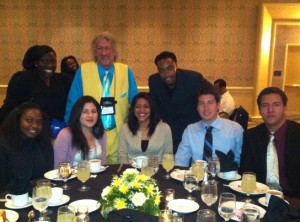Several California State University, Dominguez Hills undergraduate and graduate pre-health students–most who are members of the Pre-Health Society, a student organization–served as mentors to high school students, as well as learned and networked while at the 26th Annual Symposium on Career Opportunities in Biomedical Sciences and Health Professions sponsored by the Association of Minority Health Professional Schools (AMHPS) in April.

The annual symposium, this year hosted by Charles Drew University of Medicine and Science and held in Long Beach, targets underrepresented minority students from throughout the nation who are interested in science and health professions. Through workshops and talks led by industry professionals, and student research presentations, attendees learned about getting into professional schools, from the application process to writing personal statements, and the duration of various programs. Students also had opportunities to network with administrators and faculty members from professional health schools, including David Carlisle, M.D., Ph.D., president of Drew Medical School and Richard Baker, M.D., provost and dean of Drew Medical School.
“There needs to be an increased awareness of activities such as this, put on by minorities like this, because it’s still at the forefront of what is important in education,” said Thomas Landefeld, professor of biology and pre-health advisor at CSU Dominguez Hills. “The students who attended are underrepresented. It’s important for them to see attention is given to the issues by organizations and institutions that are committed to that and, quite honestly, for them to see other people who look like them are in these positions … For the president and provost of Drew to be there and really relate to them on a one-to-one basis is very important. Even if the students aren’t applying to Drew they know that person’s name, they know that person’s talk.”
Ricardo Placencia, a junior majoring in cellular and molecular biology, isn’t quite ready to apply anywhere; he’s still deciding which career path he will follow.
“I was able to network with students [who] are on the same path as me. I was also able to network with professionals,” he said. “It provided me with invaluable information regarding careers in the health care field.”
Placencia’s options are plentiful, with a wide range of professions from which to choose including medicine, nursing, dentistry, pharmacy, and public health. Landefeld said these and others optional career choices were covered during the symposium’s workshops. “Making Choices and Preparing for Careers in the Sciences,” a workshop led by Landefeld, provided Placencia and other students with information to help them through the decision process.
Christine Arnao, a senior majoring in cellular and molecular biology, knows exactly what she wants to do; she’s interested in infectious diseases found in dentistry and is applying to dental schools. She attended the symposium to learn more about the application process and to network.
“I was able to attend Dr. Landefeld’s workshop, where he informed us [about] the entire application process for undergraduate, graduate, and professional schools,” she said. “I also had the opportunity to attend a workshop given by a forensics specialist, nurse, and public health specialist who gave us numerous networking workshops.”
While Landefeld points to Carlisle and Baker, both African Americans who hold top administrative positions a Drew Medical School, as examples of what minority students can achieve, he maintains that “in the sciences, the number of minorities…it’s embarrassing.” Through his involvement in the AMPHS symposium, and as a pre-health advisor at CSU Dominguez Hills, Landefeld is working to change that.
“Teaching students about selecting and applying for health profession schools is as important as teaching about science in the classroom,” he contended. “I am really able to talk to students about the things they really need to do to prepare to be competitive.”
Landefeld said that creating a pipeline of minority students coming from underserved high schools, through to undergraduate and graduate programs, and professional health schools is essential to ensuring diversity in the workforce. He added that peer mentoring can help to accomplish that, and at the symposium there were a number of instances of mentorship going on, whether it was college students answering questions from high school students about different majors and the collegiate experience or student attendees learning from abstracts presented by other students.
“To me, that’s the most important thing we do in academia.” Landefeld said of mentoring. “These students are learning. Not only do they get mentored… but they are mentoring.”
For more information about the biology department, CLICK HERE.